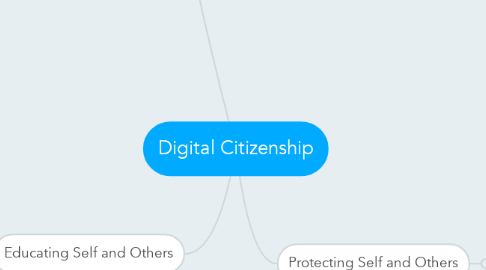
1. Educating Self and Others
1.1. Commerce
1.1.1. Password Sharing/Protection
1.2. Communication
1.2.1. Synchronous
1.2.1.1. Immediate (ex: texting)
1.2.2. Asynchronous
1.2.2.1. Independent of Time
1.2.2.2. Digital Record
1.3. Literacy
1.3.1. Resource Evaluation Criteria
1.3.1.1. Authenticity
1.3.1.2. Coverage
1.3.1.3. Objectivity
1.3.1.4. Accuracy
1.3.1.5. Currency
1.3.2. Foundation in Curriculum
1.3.2.1. Deep Understanding vs. Consumer
1.3.2.2. Beyond Technical Skills
2. Respecting Self and Others
2.1. Accessibility
2.1.1. Student (Personal) Devices/BYOD
2.1.2. Digital Networking
2.2. Law
2.2.1. Fair Dealing
2.2.1.1. Teacher/Student Resources
2.2.2. School Policy
2.2.2.1. Plagiarism
2.3. Etiquette
2.3.1. Codes of Conduct
2.3.1.1. WHEN to Use Tech
2.3.1.1.1. Time Perameters
2.3.1.1.2. Instructional Purpose
2.3.1.2. HOW to Use Tech
2.3.1.2.1. Emails, Posting
2.3.2. Teacher Modeling
3. Protecting Self and Others
3.1. Rights and Responsibilities
3.1.1. Ethical Core
3.1.1.1. Identity
3.1.1.2. Privacy
3.1.1.3. Ownership
3.1.1.4. Trustworthiness
3.1.2. Sliding Scale
3.1.2.1. Younger...Older Students
3.1.3. Philosophic Stance
3.1.3.1. One Life
3.1.3.2. Two Lives (Home/School Separate)
3.2. Health and Wellness
3.2.1. Balance Tech Use/Limit
3.2.1.1. Injuries (Stress, Strain)
3.2.1.2. Addiction
3.3. Security/Safety
3.3.1. Tech
3.3.1.1. Software
3.3.1.2. Data Protection
3.3.2. Personal
3.3.2.1. Cyberbullying
3.3.2.2. Intellectual Property - Theft
3.3.2.3. In Loco Parentis - Teacher Responsibility
